The defending Big Sky Conference champion Aggie football team opens its 2019 season with a nonconference game at Cal, Aug. 31, in the 10th meeting between the two schools and the first since 2010. The record books at both schools show Cal undefeated in all those games — but a question remains about 1939. The final score, officially, was 32-14, but UC Davis’ El Rodeo yearbook disagreed, proclaiming in print that UC Davis won the game, 14-12, which was the score after two hours, the originally agreed upon time limit. A “shocked” Cal coach insisted the game go longer, according to historical accounts.
The article below ran in advance of the 2010 game.
The day of reckoning is Sept. 4, when the Aggie and Golden Bear varsity teams will meet on the gridiron for the first time in 71 years.
They last played each other in 1939, when the Davis campus was a branch of Berkeley’s College of Agriculture. On that September day, according to San Francisco Chronicle sportswriter Art Rosenbaum, instead of being “snuffed out by this big ferocious Bear,” the Aggies “rose up and took a Sunday punch right at the big Bear’s snout.”
The official records say UC Berkeley won. Some people thought otherwise.
Davis’ El Rodeo yearbook claimed victory, 14-12. That was the score after two hours, which was all they had intended to play, in order to leave enough time in the afternoon for Cal’s game against Pacific in a second preseason game the same day.
“We were ahead of ’em at halftime and they just couldn’t stand it,” said Les “Dutch” Heringer ’40, a Yolo County farmer who played in that game at Cal’s Memorial Stadium.
Until then, Coach Leonard “Stub” Allison of the Rose Bowl-caliber Bears had been playing his reserves. But they “could do nothing with the fighting farmers,” according to The California Aggie.
At halftime, with the Aggies leading 14-6, Cal asked if the game could go full-length, the campus paper said. “The coaches of both teams and the head timer agreed … and so … ya see … that’s how it was,” the Aggie’s disappointed sportswriter said.
The El Rodeo staff saw it differently: “Allison of the Bears insisted the game be played out.”
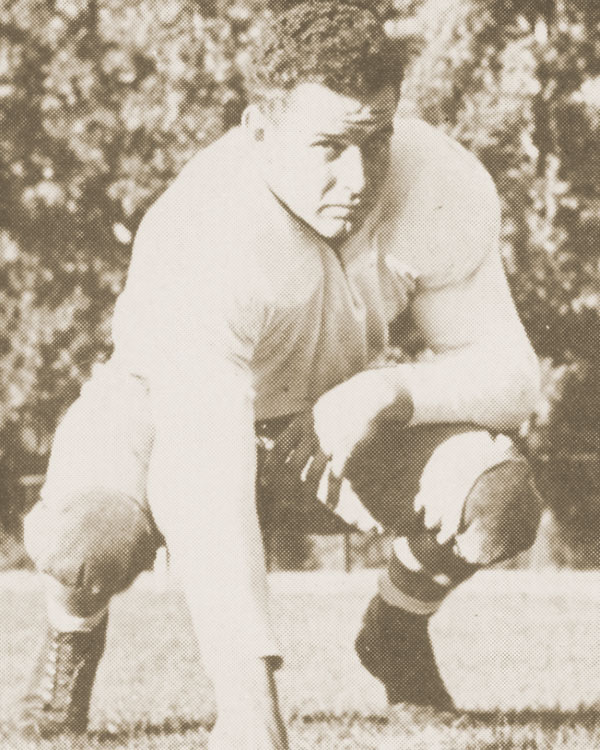
Heringer: ”We were ahead of ’em at halftime and they just couldn’t stand it.”
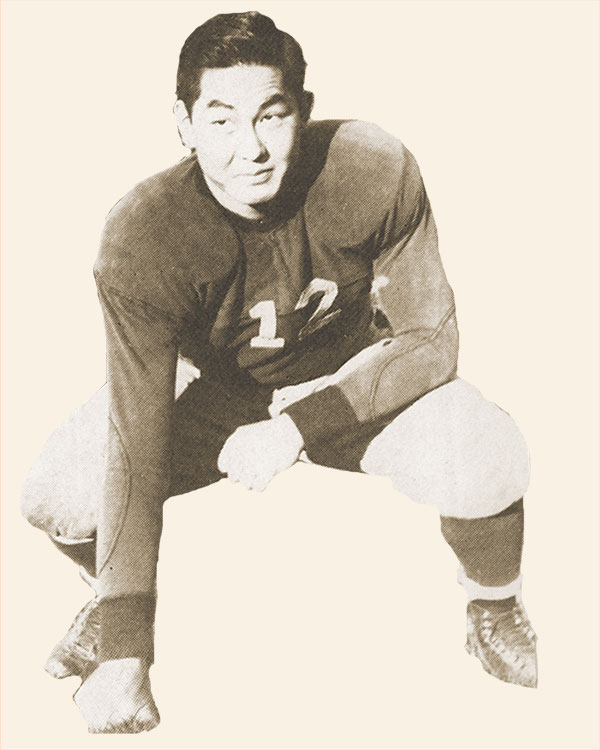
Aggie Hall of Famer Mitsuo ‘Mits’ Nitta, hero of the 1939 game, in which he blocked two punts and returned both for touchdowns.
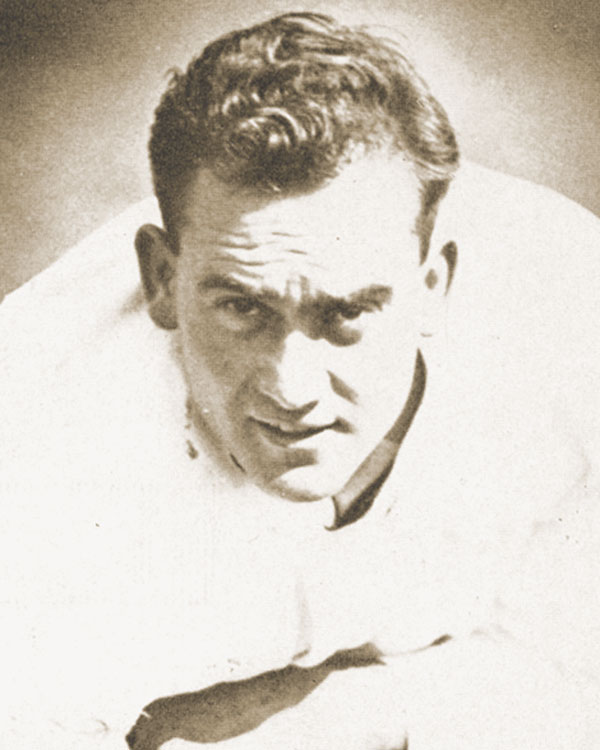
McSweeney: ”Cal — the dirtiest team I ever played against — has always been a nasty thing to say in my mouth.”
“Stub” was indeed hard-nosed, former San Francisco Chronicle and Sports Illustrated writer Ron Fimrite said in his 2009 history of Cal football: Golden Bears. “There was nothing at all ‘stubby’ about him — he was nearly 6 feet tall — except for his stubbornness in refusing to acknowledge that there was any play in the game, certainly including the forward pass, worth calling other than the off-tackle smash.”
An earlier history, 66 Years on the California Gridiron (1882-1948), doesn’t talk about the extra playing time in the 1939 game. But the author, S. Dan Brodie, described how “the shocked ‘Stub’ Allison” called on his first team to start the second half.
Or, as the Aggie newspaper put it, he turned to his “big guns,” hoping they would “subdue the despised country cousins.”
Still, the Aggies held off the Bear starters until well into the third quarter, when Cal closed the margin to 14-12. And that’s where the score stood at 3 p.m., the agreed upon time for the game’s end.
In the extended play, Cal won 32-14, or so say the UC Davis and Cal records, and newspaper accounts in Davis, Sacramento and the San Francisco Bay Area. Only the campus paper mentioned the original time limit.
The UC Davis and Cal athletics files do not address the length of play, but the El Rodeo staff wasn’t about to let it go. They described the added time as a “scrimmage” — and refused to acknowledge it.
There is no disputing that the Bears won the seven other games in the 1932-39 series or that the Bears generally outmatched the Aggie Mustangs, as they were called then. These were more or less practice games, or “breathers,” for the Bears, a major force in the Pacific Coast Conference of the day.
“The idea was to play two inferior teams early, and in this quasi-scrimmage format give game experience to players previously lost in the shuffle,” Fimrite said in Golden Bears.
No one really expected the Aggies to win. Nevertheless, the “local boys” relished the opportunity to go down to Berkeley to play their blue-and-gold brothers.
It was all about the competition, the love of the game. “Football is football. You don’t worry about who’s on the other side,” the 91-year-old Heringer said from his home in Clarksburg.
Howard McSweeney liked the football (he played in 1936, ’37, ’38 and ’40), but he also liked the travel. “It meant you got a couple of steak dinners,” which no doubt took some of the sting out of getting knocked out two or three times a game.
“We didn’t get helmets until the second year,” the 95-year-old recalled during an interview at his Santa Cruz retirement home. Those helmets didn’t have face masks, and McSweeney recalled having his front teeth knocked loose one time. “I straightened ’em up, put a mouth guard in and kept playing.”
McSweeney, team captain in ’38, recalled Cal as “the dirtiest team I ever played against. … Cal has always been a nasty thing to say in my mouth.” During the 1936 game, McSweeney said, one of Cal’s “big bruisers” gave him a knee to his right side continually, putting him in the hospital for five days.
“They were ruthless,” he said. “It’d be different if we had a chance or anything,” but they were playing 270-pounders vs. guys like McSweeney, listed at 5-foot-10 and 170 pounds on the Aggie roster. (Of course, he did some “pounding” of his own, as noted by The Davis Enterprise after the 1938 game.)
Some Aggies didn’t mind sacrificing their bodies for the chance to play in Memorial Stadium, which had opened in 1923 with a capacity of around 80,000.
Yoshio “Ping” Oda grew up in Berkeley and, as a youngster, attended the Cal games regularly — getting free admission to the kids section.
“We used to sit on the south end of the stadium and the teams used to come out from a tunnel from the north end,” Oda said in an oral history interview that became part of the Legacy of Aggie Football video in 2004. (He died at age 89 in 2002.)
“I used to dream that, boy, if I could only be, you know, when I get big, I was dreaming that one of these days I hope I could come through that tunnel,” Oda said.
That day would come Sept. 17, 1932, the first time the Aggies took on the Bears. Oda recalled “tears were coming out of my eyes” as he entered the stadium. “By golly, the dream came true.”
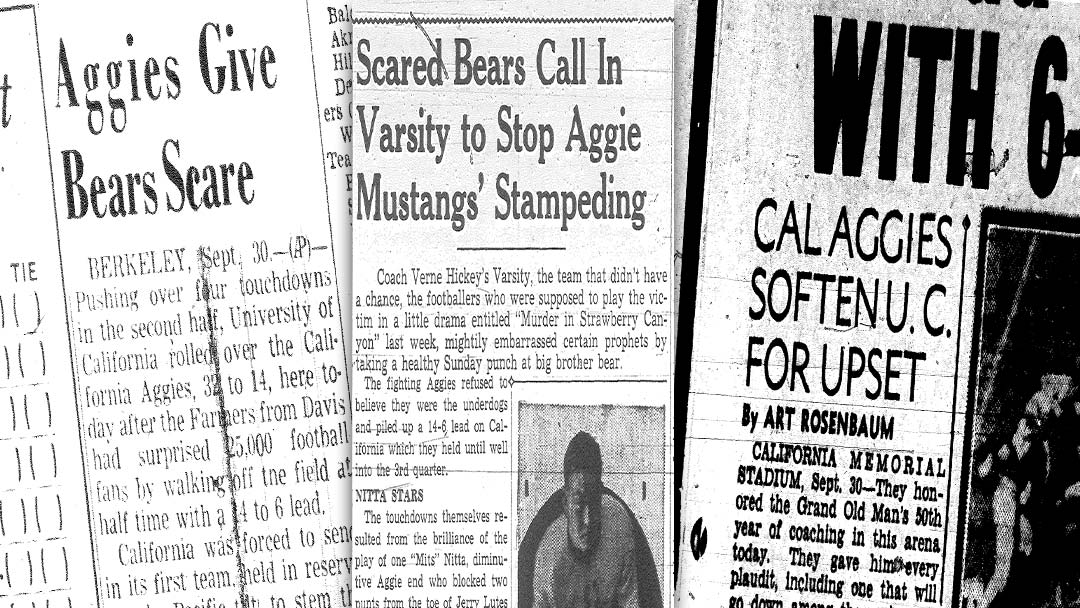
The Bears had been to the Rose Bowl in 1921, ’22 and ’29, and, as Allison’s “Thunder Team,” would go again in 1938. Allison’s Bears went 35-7-1 (including a Rose Bowl win) in his first four years, winning the Pacific Coast Conference championship in 1937, and sharing the conference title in ’35 and ’38.
In short, Cal was big league. The University Farm in Davis was, quite literally, farm league.
“We were just a fledgling program in the 1930s,” said Bob Biggs, head coach at UC Davis since 1993. “Our enrollment was only 1,000 or so, but we still had a football team. And it was just as important for those guys as it is for our team today.”
In the 1930s, besides taking on Cal (with some 9,000 to 14,000 undergraduates at the time), the Aggies played some other big names, too, including Stanford and UCLA. Eventually, UC Davis and some of its early opponents went their separate ways, into the NCAA’s Divisions I and II.
Over time, UC Davis matured into a major university with an enrollment similar to Cal’s — and today the football team finds itself in the same division with the big boys, albeit still at different levels: The Bears are in the Football Bowl Subdivision and the Aggies are in the Football Championship Subdivision.
“It isn’t apples and apples, but it isn’t apples and oranges, either,” Biggs said. “It’s apples and pears.”
Since UC Davis football began its transition to Division I in 2003, the Aggies have been taking on tougher opponents: Stanford, Texas Christian University, Fresno State, Boise State and now Cal.
“Our players are competitors. They go into every game thinking they are going to win,” Biggs said. “They also go in with a chip on their shoulder, knowing that Cal or Stanford or Boise State might be thinking the Aggies are not quite good enough.”
Indeed, those other teams have more scholarships (85 vs. 60 for the Aggies) and recruit players who are often bigger, stronger and faster than the Aggies. “But it’s a challenge we look forward to,” Biggs said. “It’s an opportunity for us to take our program to another level.
“We play as hard and as well as we possibly can. And if a few bounces go your way, well, anything can happen.” Just ask Stanford, which fell to the Aggies, 20-17, in 2005.
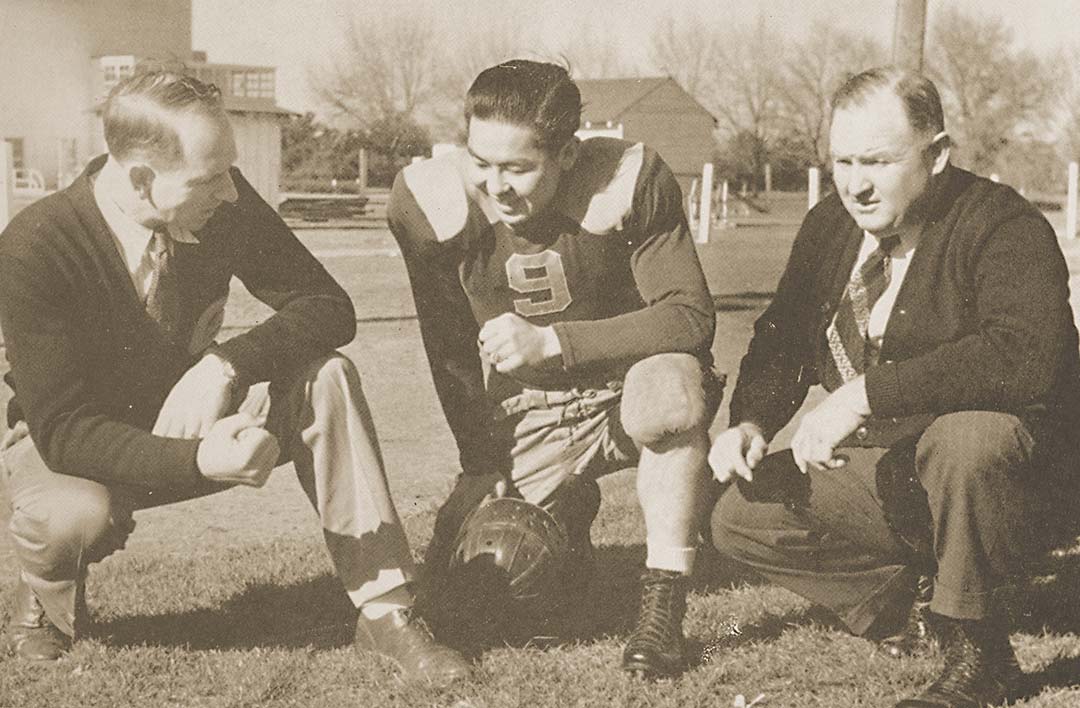
Coaches Vern Hickey and Woody Wilson discuss strategy with captain Mitsuo “Mits” Nitta.
Cal scheduled a doubleheader for Sept. 30, 1939, taking on the Aggies in the first game and the Tigers of the College of the Pacific (now the University of the Pacific) in the second — in what Fimrite would describe 70 years later as a “fateful twin bill.”
Cal’s “Stub” Allison knew that the “Grand Old Man of Football,” Coach Amos Alonzo Stagg, was preparing for his best year ever at Pacific. “Thus, (Allison) saved his regulars for that contest and turned the Aggies over to seconds and thirds,” Brodie wrote in 66 Years on the California Gridiron.
“What ‘Stub’ didn’t know, however, was that Vern Hickey, coach of the Aggies, was also preparing for one of his better seasons.”
After Cal scored an early touchdown, the Aggies buckled down, refusing to be “bowled over the way they were supposed to,” quoting from the Oakland Tribune.
In holding their ground, the Aggies forced the Bears to kick the ball away — and Matsuo “Mits” Nitta ’42 took advantage not once but twice. Both times he ran past a defender like a cyclone, wrote the Tribune’s Lee Dunbar, blocking the Cal punts. “The ball hit his chest, he wrapped his arms around it and was on his way to the end zone.”
With his speed at the right time and in the right place, the Aggie end put 12 highly prized points on the Mustang scoreboard, according to The Davis Enterprise. Two more points on kick conversions gave the Aggies their biggest score ever against the Golden Bears.
And, though Cal’s first-stringers came in to save the day, the Aggies took consolation in what happened next: Pacific defeated the Bears, 6–0, in what the papers of the day described as “a cataclysmic upset” at the hands of the Stockton “musicians school.”
The Aggies got much of the credit and left many people thinking that the Aggies could have beaten the Bears, too.
“Cal Aggies Soften UC for Upset,” the San Francisco Chronicle’s headline declared. “California was fortunate to come out of this nightmarish opening day without two defeats instead of one,” Rosenbaum wrote. “In the first portion of this ‘double breather,’ the Bears defeated (the) California Aggies, the little cousin from Davis, 32 to 14, and there will be many who contend the Aggies really beat California in that second game — not Pacific.”
Rosenbaum described how Cal’s first team, “hastily drafted to battle,” did its work well against “a tiring Davis cousin” — but the battle took a toll on the Bears. “When the varsity was needed for points later on (against Pacific), the Aggie breather had left them breathless.”
In his Golden Bears history book, Fimrite would say of Cal’s first-stringers: “They simply pooped out.”
The Sept. 30 doubleheader marked the beginning of the end for the “Stubber.” The Bears would go 3-7 in 1939 and do no better than 5–5 through 1944, Allison’s last year as coach, this after he started his Cal career with four straight winning seasons.
As for those doubleheaders, Allison dropped them after the 1939 “mishap,” Fimrite said.
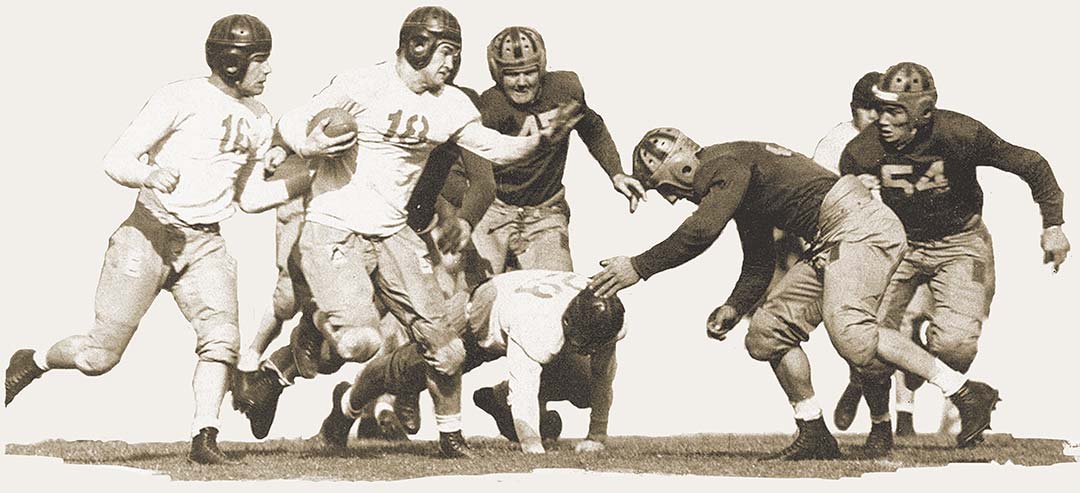
No matter how big a name or how big a stadium an Aggie opponent has, “the exciting part for our players is the support they have from the UC Davis community, our students, our staff, our alumni,” said Coach Biggs, who expects as many as 15,000 Aggie fans to attend the Sept. 4 game in Berkeley.
UC Davis will receive a guaranteed $300,000 from Cal, as well as 5,000 tickets to sell (with the Aggies keeping the proceeds). Altogether, the payday for the athletics budget is likely to exceed $500,000 — a record high for the university.
Cal guaranteed the Aggies $750 in 1939, and, after being manhandled, no doubt wanted its money back.
The Davis Enterprise summed it up with this headline: “Aggies Give Bears Uncomfortable Saturday Afternoon.” The accompanying story said: “It is generally believed if Pacific had played California first, the Aggies might have ended on the winning side in the second game.”
The campus newspaper’s Pat Bowman wrote in his “Sport-O-Graphs” column: “We don’t want to get snotty, but by Gawd we should have played the Bears second.”
Or, at the very least, the game should have ended when it was supposed to end. “We had ’em beat,” McSweeney said.
Coach Biggs joked about asking Cal Coach Jeff Tedford to make amends. ” Maybe we can start with a scrimmage: our backups against his starters,” Biggs suggested.
“We’ll try to wear ’em down, and then we’ll start the real game, our starters against their starters, so we can have a chance to win, just like Pacific in 1939.”
In truth, Biggs said, he and the Aggies don’t want a head start. They will play Cal straight up, on behalf of all the Aggies since 1939 who dreamed of playing the Bears but never got the opportunity.
“We have a long history of playing in Cal’s shadow,” Biggs said. “Whether we win or lose, if we give it our best effort, we will feel good about it.”
